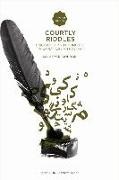Read more
This is the first study of Persian literary riddles to appear in English, analyzing a wide range of complex riddling poems systematically from the tenth to the twelfth century. In addition to the genre of riddles, the book examines the relationship between metaphors and riddles and the genre of literary description.
Literary riddles occur in the early specimens of Persian literature from the tenth century and they continue to be used in modern Iranian society.
What is it that it has neither trousers nor shirt?
[Yet] you can place on her lap whatever you wish
Although she has no tongue, she speaks the truth,
With a dragon, a scorpion upon her neck.
a scale (quppân)
A.A. Seyed-Gohrab is track-leader of the Persian Studies Programme Leiden University and elected member of the Young Academy of the Royal Netherlands Academy of Arts and Sciences (KNAW).
¿Courtly Riddles demonstrates how the taste for riddles lies at the core of the development of Persian poetry. It proposes a careful, learned and systematic analysis of this hitherto little-studied and puzzling poetical game.¿
Christine van Ruymbeke, University of Cambridge
List of contents
Courtly Riddles - 2 Table of Contents - 8 ACKNOWLEDGMENTS - 10 PART ONE - 11 Chapter One The Eloquent Mute - 12 Chapter Two Inimitable Simplicity - 21 PART TWO - 71 Chapter Three "Words Covered in Veils" - 72 Chapter Four 'A Nightingale without feathers': Riddlers of the Late Ghaznavid and the Early Seljuq Periods - 86 Chapter Five The Virtues of the King: Riddles in Mukhtaern's Hunar-naema - 146 Conclusion - 201 References - 204 Index - 216
About the author
Dr. A.A. Seyed-Gohrab is track-leader of the Persian Studies Programme Leiden University and Vice-Chairman of the Young Academy of the Royal Netherlands Academy of Arts and Sciences (KNAW).

